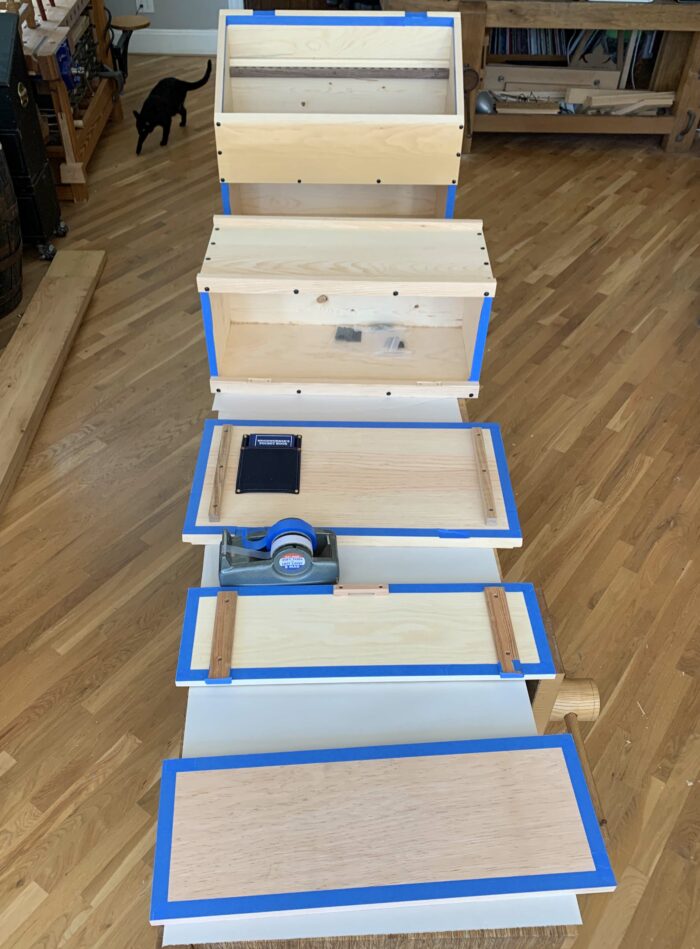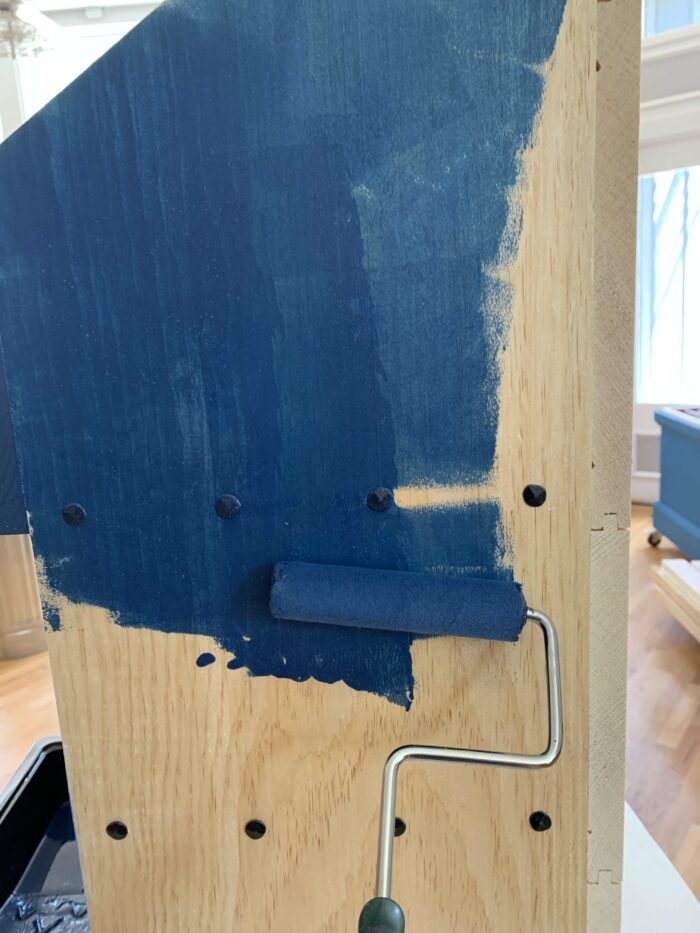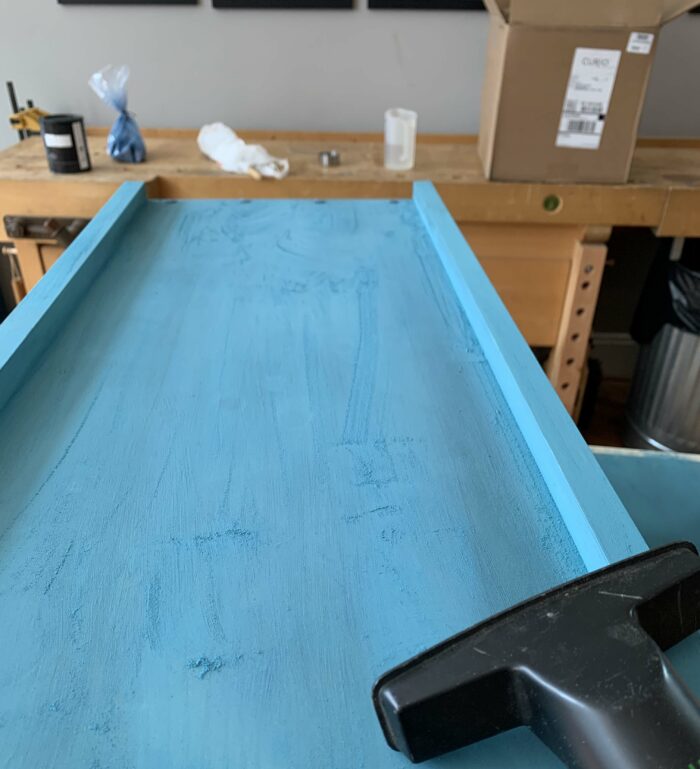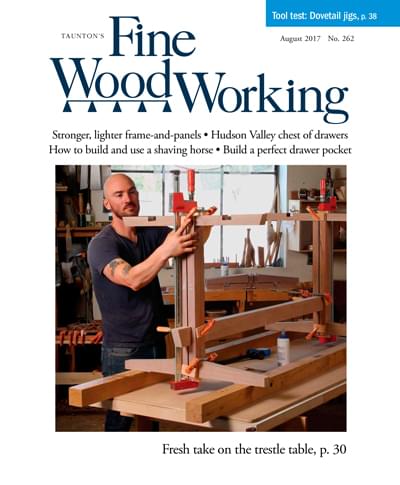No shame in painting (or in using a roller to do it)
It's often historically accurate to paint furniture, plus it's a great way to dress up and protect the wood.

A few weeks back, I posted a picture on Instagram of my using a 4-in. roller to paint a tool chest. From some of the comments and direct messages I got, you’d think I’d knocked someone’s ice cream to the ground or kicked their dog. But I stand by my roller use. Below is what I learned from a professional painter, combined with my own experience, about painting furniture.
Tools
First, buy good brushes and take care of them; they’ll last for years. (I’ve used my trusty 2-in. angled Purdy for two decades on both walls and furniture.) I keep a supply of 1/4-in. and 3/16-in. nap rollers on hand in 2-in. and 4-in. sizes (and the roller frames, of course), as well as small paint trays. (I don’t like foam rollers; I find they can introduce air bubbles). And you’ll need sandpaper or a fine (or extrafine) sanding sponge; I prefer a sponge.
Preparation
If I’m using latex or acrylic paint, I’ll sometimes go over a build’s show surfaces to look for dings. If I can’t steam them out, I’ll fill them with Durham’s rock-hard water putty. A small scoop in a Dixie cup mixed with a little water to reach the consistency of creamy peanut butter, and it’s good to go. (You can’t beat it for price, and I’ve yet to have it shrink out.) I press it into the dent (or knot hole) with an old palette knife, let it dry for a minute or so, then use the side of the blade to remove any excess and level it. After the patch is dry, sand it smooth. With milk paint, I fill dents only if I’m going to be building up the paint for a near-opaque finish (I don’t want the filler to show).
If there are any doors, lids, locks—anything with hardware—remove the hardware. Then tape off any edges of what will remain unpainted. Try not to be sloppy; tape is not a 100% guarantee that you’ll avoid bleed.
As with any finish, I break all the sharp edges before applying paint, and either vacuum or wipe off the sawdust. (I’m assuming the panels are already finish planed or finish sanded. If I didn’t plane, I sand to 180 grit when painting.)
I don’t typically use a primer unless I’ve filled lots of knot holes or dings on the show surfaces. It doesn’t hurt to use one, of course, but I find it easier in most cases to simply count on an additional paint coat; that way there are fewer brushes to clean. If I’m painting a particularly resinous wood, however, I’ll spray or brush on a thin coat of shellac to seal it before painting.
And finally, if you’re using milk paint, prep a test board of the same species as your project, and finish-sand or plane it just as if it were part of your build. After all your coats are dry you’ll likely want to either burnish the paint or add a topcoat—but you don’t want to do anything without testing it first.

Kinds of paint
I use three kinds of paint on furniture (well, four … but the fourth is linseed oil paint, and I use it but rarely).
1. Latex, if I’m in a hurry or it’s Sunday. (My local hardware store, open on Sundays, carries Benjamin Moore. If I want anything other than latex, I have to plan ahead.)
2. General Finishes (faux) milk paint. I like this paint; it goes on pretty much like latex but has less sheen than even the flattest latex. And unlike latex, it allows a hint of the wood grain to show through (with one or two coats). It’s a 42-mile round trip for me to pick this up, so I usually order it online and await delivery.
3. Actual milk paint. This is my favorite paint finish for furniture (and especially tool chests). After it’s completely dry, it’s incredibly hard-wearing, and I like its dead-flat, almost chalky look (but it also looks nice with an oil or other topcoat, which darkens the dried paint and gives it a nice glow). But my favorite milk paint isn’t available at any retail locations in my town (the nearest brick-and-mortar retail seller is 100 miles away), so I have to plan ahead and order it. And unlike latex or the faux milk paint, it has to be mixed, and has a short shelf life once water has been added. Plus it typically takes more coats, and is a bit harder to apply than the other two. So for commission work, there’s an upcharge. (If you want to learn to apply this finish from a milk paint pro, I recommend Peter Galbert’s videos.)
Application
First, break the project into sections in your head. For example on a Dutch tool chest, I paint panel by panel, doing any cutting-in and painting edges with a brush. If I’m using latex or acrylic paint, I then use a roller to apply it to any large, flat surfaces. With milk paint, however, I always use a brush in the direction of the grain. It dries quickly, and I like seeing the brush marks in milk paint (like jack plane scallops on the underside of a tabletop or slight variations in dovetails, those brush marks say “handmade” t0 me). Latex and acrylic have a long enough drying time that they lay out flat, brush or no—so I might as well use a roller; it’s faster. I do one panel at a time so that I can always keep a wet edge; that helps to avoid lap marks in the dried paint.

And I always keep my brush in my left hand while using the roller with my right. That way, if the roller leaves a glop of paint on an adjacent edge (or a drip), I can quickly brush it away. I try to catch any such errors while the paint is wet; it’s a lot easier than sanding them away later.
Speaking of sanding, after the first coat dries thoroughly, you’ll almost certainly have to sand—particularly with water-based paints—whether or not you have unsightly drips or edges. I don’t bother raising the grain and sanding back before painting. The few times I’ve done so, I still had to sand after the first coat, so why bother? I use a superfine sanding sponge and go over every surface just enough to smooth it without cutting through the paint. And if I’m sanding milk paint, I wear gloves and usually a mask. It powders up more than latex or acrylic (or at least my coats do; I mix it fairly thick), and the dust turns my hands and mucus to whatever color I’ve painted (rainbow snot!). I always use a vacuum on the milk-paint dust.

Now repeat. And you might even have to do a third coat to get the coverage you want. Or you can layer colors then distress high-wear areas for instant age (or just wait a year or three for the undercoat to start showing in places). You likely won’t have to sand the second coat of latex or acrylic, but do sand the milk paint between coats (I use a fine sanding sponge).
Once latex paint is dry, you’re done. I don’t put topcoats on the acrylic, either, so once it’s dry, I’m done. General Finishes does sell a topcoat that the company says will make the paint wear harder and change the sheen (if I wanted shiny, I’d probably have used a semi-gloss or gloss latex in the first place). But for milk paint, I recommend burnishing the surface with 1,200-grit sandpaper or a folded brown paper bag. This will knock off any bumpy mineral deposits and keep them from coming off later on your hands or clothes. You can also apply a topcoat of oil, wax, oil and wax, varnish and oil, and burnish that to give the surface a warm glow and make it look and feel less chalky. (I like the chalky look.)
As I’ve written before, I don’t understand why paint sometimes gets a bad rap these days. Not only is it an historically accurate treatment in some cases, it’s a great way to dress up and protect wood – particularly on items that see a lot of wear, such as tool chests. I also like it for brightening up the interior backs of cabinets (and covering up the secondary wood I typically use there).




























Comments
I saw the blog title, and knew it had to be you.
I'm a big fan of milk paint. A bit of a learning curve and a bit more work if you've only ever used latex, but the finish is totally worth it.
Log in or create an account to post a comment.
Sign up Log in